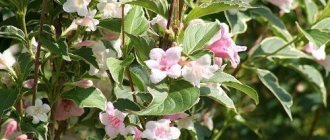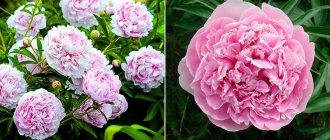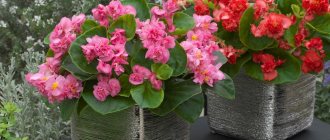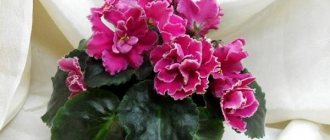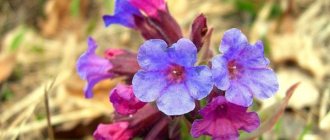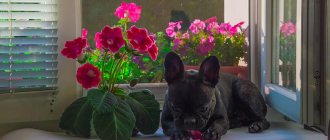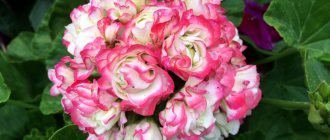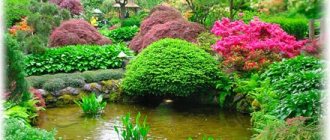Rhododendron (Rhododendron) is an evergreen, semi-deciduous and deciduous plant from the Ericaceae family. But according to various sources, the genus includes from 800 to 1300 species. In the wild, rhododendrons are common in North America and Southeast Asia. The culture received its name from the words “rhodon” (rose) and “dendron” (tree), that is, “rose tree”. Rhododendron flowers really look like roses.
The plant prefers to grow in coastal regions, semi-shaded undergrowth and mountain slopes. Many species have become widely cultivated in horticulture. Due to the diversity of the genus with flowers differing in size, shape and shade, you can choose rhododendron for planting according to your taste. It reproduces easily and has moderate care requirements.
Rhododendron: types and varieties for open ground
The genus is very numerous and became popular in home gardening back in the 17th century. Every year, decorative species are replenished with new varieties, of which there are already more than a thousand. In temperate latitudes, the following types of rhododendron are most often cultivated.
Japanese
Deciduous, highly branched shrub up to 2 m high. Leaves are lanceolate, elongated. In summer they are green, in autumn they are orange-red. The flowers are bell-shaped, up to 8 cm in diameter, orange, collected in racemes of 6-12 pieces. The bush blooms simultaneously with the blossoming of young leaves.
Schlippenbach
Shrub 2-4 m high. Leaf blades are ovoid, wavy at the edges, dark green. Flowers up to 10 cm in diameter, bell-shaped, pale pink, have purple specks inside. Collected in umbrella inflorescences of several pieces. The species is frost-resistant due to the fact that young shoots quickly become woody.
Holofloral
The plant is 1-2 m high. The leaves are green, oblong, 8 cm long. They have cilia along the edges. The species blooms from May to June with light pink tubular flowers. The shrub grows only 3-5 cm per year. It loves acidic soils, good lighting, and is characterized by high cold resistance.
tree-like
Deciduous shrub up to 3 m high, native to North America. The leaf blades are elongated, bright green on top, bluish on the underside. In autumn they turn purple. Flowering begins in July and lasts about 1 month. The flowers are white or pink, about 5 cm in diameter. The species likes to grow in moist soils with a slightly acidic reaction. Annual growth averages 5-7 cm.
Sikhotinsky
Semi-deciduous shrub with a height of 30 cm to 3 m. Depending on the growing conditions, the crown may change. The shoots are pubescent, red-brown. The leaves are leathery, dark green. The color of the flowers can vary from pink to dark purple. The flowers are bell-shaped, up to 6 cm in diameter. The shrub can bloom twice a year. The plant is not capricious, is frost-resistant, and grows only in acidic soils. As a rule, it is grown in collection gardens.
Pukhansky
An evergreen plant 0.6-1 m high. It has a compact crown. The leaves are oblong, lanceolate, dark green in color, and have a pubescent edge. The flowers are funnel-shaped, pale lilac with brown speckles. The species blooms in May simultaneously with the leaves blooming. It grows only 2 cm per year. It loves light and is resistant to cold, but requires shelter for the winter.
Yellow
A shrub up to 3 m high with yellow fragrant flowers that bloom in May.
Adams
An evergreen species that grows in the Far East, as well as in Tibet. Shrub up to 50 cm high, with pubescent shoots in the form of glandular pile. The leaves are matte, dense, oblong-elliptical. On the front surface they are smooth, on the back they have scales. The inflorescences are corymbose, collected from 7-15 flowers of different shades of pink.
Hybrids
This is only a small part of the varieties of rhododendrons that can be grown in garden plots. Today, many varieties and hybrids (including evergreens) have been bred that have high frost resistance and are suitable for cultivation in temperate climates.
Some varieties of hybrid Rhododendrons:
- Western Light;
- MistMaiden;
- Ken Janeck;
- Alfred, Boursault;
- Abraham Lincoln;
- Flauntado;
- Haaga.
general information
Despite the fact that the name rhododendron literally translates as “rose tree,” it has nothing to do with roses. The only thing they have in common is the variety of varieties and fabulous beauty during flowering. And rhododendron belongs to the heather family.
It is most commonly found in the Himalayas, Southeast Asia and Southern China. Some species grow in Japan, North America, New Guinea and Australia. But they are all very different, from tiny creeping shrubs to entire trees.
The length of rhododendron stems in the wild can reach an astonishing 30 m. The flowers can be quite miniature, and sometimes exceed 20 cm in diameter. But there are also compact varieties that love to be grown on windowsills.
Photo: shark-media.ru
Growing from seeds to seedlings
The seed method is only suitable for species rhododendrons. Before planting the plant in open ground, the seeds are grown for seedlings.
Soil and container
Sowing can be done from the end of December to the end of March. Sowing at the end of November is also allowed. Prepare shallow bowls or containers.
Fill the container with an earthen mixture, which consists of equal parts:
- turf;
- coniferous land;
- sand;
- peat
Before planting, it is better to soak the seeds in water for a day. Distribute them over the surface of the substrate, do not deepen them. Moisten the crops using a sprayer. Sprinkle clean sand on top and cover the crops with glass. Place the containers in a bright place for germination.
Seedling care
For normal seed germination, it is necessary to provide planting with light for 12 hours. To do this, it is recommended to turn on additional lighting. Remove the cover daily to ventilate and moisten the substrate. Shoots may appear within a month. When the seedlings have their first leaves, they are planted at a distance of 2x3 cm from each other. For normal development of the root system, seedlings need to be deepened into the soil by cotyledons.
Transplanting
During the first year of life, seedlings are grown in a cool greenhouse. It can only be planted on the site next year. First dig up the soil, add sand and peat to it. For each seedling, dig a hole slightly larger than the size of the root system. Place the seedlings in holes with a lump of earth strictly vertically. Sprinkle with soil, compact it and water.
Description of culture
Garden rhododendron is a shrub that is quite popular all over the world due to the beauty of its foliage and magnificent flowering . Some species of this plant emit a bright floral aroma. The foliage of the crop can be annual or perennial depending on the variety.
The fruit of the bush is a small capsule with seeds. The bush has a fairly shallow root system, which makes it easy to transplant the plant to another location.
Rhododendron is an excellent early honey plant. Very popular among beekeepers.
Planting in open ground
A more convenient and faster way to grow rhododendron is to plant a ready-made seedling.
Selection of seedlings
More often, seedlings from nurseries in Holland and Germany are sold in stores. Varieties of Finnish selection are also valued. They are sold in pots. When purchasing, you need to make sure that the root system of the plant is in order. The earthen ball should be entwined with roots. It’s good if they show threads of mycorrhiza, which allows the roots to absorb nutrients normally. Before purchasing, you need to remove the plant from the pot to make sure everything is in order. The leaves should not have any spots, there should be no mold or white coating on the trunk.
Before purchasing a seedling, it is worth studying the group to which it belongs, its variety and origin (species or hybrid). Also take into account the size of the shrub in adulthood, its frost resistance, and growth rate. Beginning gardeners should not purchase many copies of the plant. It is better to stop at one and make sure that they are capable of growing rhododendron.
Choice of location and lighting
Rhododendrons can grow in almost any area.
The main thing is that it is protected from direct sun and strong wind. It is preferable to choose semi-shaded areas. But some deciduous species can grow in well-lit places. On a note! The culture does not like stagnant moisture. Therefore, you should not plant it in closed lowlands, hollows, wetlands and flooded areas. Groundwater must be at a depth of at least a meter to the surface. The soil for shrubs is loose, well-drained, with a lot of humus and an acidic reaction.
Landing dates
In temperate climates, it is advisable to plant plants with high cold resistance. Spring planting of seedlings can be carried out from April to mid-May. The best time for this in the fall is September. Although you can choose any time during the growing season, except for the flowering period, as well as within 1-2 weeks after it.
Landing rules
Dig a planting hole with a diameter of 60 cm and a depth of 40 cm. Fill it with a mixture of 3.5 buckets of loam and 8 buckets of high-moor peat. Compact well, then dig a hole equal in size to the root system of the seedling. Place the plant in water before planting and wait until bubbles begin to appear. Place the seedling in the hole, fill it with soil, and compact it well. Do not deepen the root collar. Water the bush generously so that the water saturates the soil to a depth of 20 cm. Cover the trunk area with mulch (peat, pine needles, oak leaves) 5-6 cm thick. If only one rhododendron seedling is planted, it needs to be supported. When the bush takes root well, it can be removed.
What is a garden azalea?
Most garden varieties of rhododendron are shrubs of various shapes. The root system of plants is formed quite compactly and is located quite close to the surface, which makes it possible to transplant a flower from flowerbed to flowerbed without much difficulty.
The rhododendron plant, photos of which are presented in the review, may have petiolate or sessile leaves, located alternately on the shoots. The shape of the leaves is serrate or with a solid edge, obovate or egg-shaped. The color of the inflorescences can also be very diverse - lilac, violet, red, white.
As a rule, rhododendron flowers are collected in brushes or corymbs. Their shape directly depends on the subspecies and variety. She may be:
- funnel-shaped;
- campanulate;
- wheel-shaped;
- tubular
It should also be noted that individual varieties of rhododendron differ in aroma. Some smell very sweet and sharp, others are gentle and soft.
Some varieties of indoor rhododendron flowers can produce fruits in the form of a five-leaf box containing two-millimeter stick seeds. The root system is quite compact, consisting of a huge number of fibrous roots intertwined with each other.
In nature, the flower can occur as a single plant or grow in a group, forming impenetrable thickets with sufficient moisture and in shady places.
Outdoor care
As with other garden crops, caring for rhododendron includes classic manipulations (watering, weeding, fertilizing, pruning). For the successful development of the shrub, their competent implementation is necessary.
Watering
Correct watering is of great importance. This significantly affects the formation of buds. Only soft water is suitable for irrigation. It can also be acidified and softened with high-moor peat. Add it a day before watering. Acidify the water with oxalic, citric or acetic acid (3 g per 10 liters of water).
During watering, the soil should be saturated with moisture 20-30 cm deep. It is important that there is no stagnation of liquid, otherwise the root system will suffer. The standard watering rate is 1-1.5 buckets of water per adult plant once a week. Young rhododendrons are watered more often, using 5 liters of water per bush. In dry weather, including autumn, the plant's need for water increases. When the air is dry and hot, you can spray the bush.
Feeding and fertilizer
The crop needs to be constantly fed, even if it was planted this season. Fertilizing begins in early spring and ends at the end of July, after flowering ends. First, half-rotted manure is added, it is diluted with water 1:15 and infused for several days. Before fertilizing the bush, it needs to be watered. Mineral compounds are also useful for rhododendron: superphosphate, potassium sulfate, potassium phosphate, ammonium sulfate. Potassium, magnesium and calcium are added in very low concentrations.
Bush formation and pruning
Rhododendrons practically do not need pruning, since their crown contours are regular. Sanitary pruning of dry branches is carried out periodically to rejuvenate the bush. The procedure is carried out in early spring. If the cut stems are thinner than 4 mm, then they are treated with garden varnish. You can shorten the shoots to make the plant bushier. But leave at least ¾ of their length. It is also recommended to remove all dry inflorescences after flowering. This stimulates the formation of new buds.
Fertilizing bushes
This plant must be fertilized, even if recently planted. The first feeding is carried out in the spring. Before fertilizing, the plant must be watered. For organic fertilizers, manure diluted with water is suitable. Since the shrub grows in acidic soil, nitrogen fertilizers and potassium phosphate can be used as mineral fertilizers.
It is best to fertilize the plant in the spring with nitrogen-containing fertilizers, and in early summer with sulfuric acid fertilizers.
Protection from pests and diseases
If a rhododendron grows in a swampy area and suffers from waterlogging, it may be susceptible to fungal infections: rust, chlorosis, spotting, and root rot. To combat them, use a solution of copper sulfate and Bordeaux mixture. It is also necessary to regulate watering and avoid stagnation of moisture.
Rhododendron pests:
- mealybug;
- scale insect;
- bug;
- rhododendron fly;
- slugs and snails.
Gastropod pests must be collected manually, and then treated with a fungicide for preventative purposes. The fight against weevils, bedbugs and ticks is carried out with the help of Diazinon. Scale insects, scale insects and rhododendron flies are destroyed with an insecticide (Fitoverm, Karbofos, Aktellik).
Reproduction
The seed propagation method is suitable for species of rhododendrons. Varietal and hybrid plants are best propagated vegetatively.
Cuttings
Cut 5-8 cm cuttings from semi-lignified shoots. Remove the lower leaves, treat the sections with a root formation stimulator (Epin or Kornevin). Plant the cuttings in a peat-sand mixture (3:1). Cover them with film or glass. Periodically remove the cover for ventilation and watering. Cuttings take 1.5-4 months to take root. They are grown in a box filled with pine needles and peat (1:2). In winter, they should be in a bright and cool room (+8..12°C). In spring, a container with cuttings is buried in the open ground. There they grow for another 1-2 years.
By layering
The easiest and fastest propagation method. In the spring, select the lower shoot, bend it to the ground into a prepared groove 15 cm deep. Secure it with something so that it does not straighten. Fill the groove with soil combined with peat. Tie the top of the shoot to a vertical support. After rooting, separate the cuttings from the parent bush and replant.
Autumn care, shelter
Most rhododendrons cannot tolerate severe winter frosts. Therefore, starting in the fall, they need to be provided with shelter. Do this after the first frost. Sprinkle the horse's neck with dry leaves, preferably oak leaves. It is recommended to cover low-growing varieties completely. Make a frame around the bush and cover it with lutrasil. The branches of taller rhododendrons are bent to the ground and pinned with hooks. Cover the top with spruce branches. Evergreen varieties that overwinter with leaves must be protected from direct sun. Frames are made for them from roofing felt or plywood. They protect the bush not only from the sun, but also from strong winds.
With the onset of spring, when the snow melts, the frame can be removed. It is better to choose a cloudy day for this. In regions with warm climates, many types of rhododendron do not need shelter, as they are considered quite frost-resistant.
Rhododendron in landscape design
This plant is picky about how it is used in the landscape. Rhododendron will not find its ideal place everywhere and not with all crops. This is most often due to the requirements of the bush for the soil - it should be acidic or slightly acidic. It can be surrounded by plants with similar requirements.
Rhododendron can be planted as one bush on the lawn or under the canopy of a canopy tree. It looks good in hedges, in the landscape of squares, parks, and forest parks. This is an effective addition to heather gardens and pine groves.
Low-growing varieties are suitable for growing in mixborders, decorative flower beds, and alpine hills. They can also be planted in pots and used to decorate gazebos, terraces, and winter gardens. Many varieties are grown for cutting. Flowers can remain fresh for up to 2 weeks.
Rhododendron is one of the most beloved and beautiful flowering shrubs. Its bright flowers appear in the spring, when many plants are just opening their leaves. There are many types of rhododendrons that are cultivated in garden plots. They not only differ in appearance, but also in care requirements. Therefore, to successfully grow a shrub, you should familiarize yourself with its features in advance.
Video - recommendations for choosing a seedling, planting features and rules for caring for garden Rhododendron in open ground:
History of origin
Dwarf rhododendron is an alpine endemic in the East. Their range is limited; unfortunately, natural species belong to rare plants; many varieties are listed in the Red Book.
Dwarf rhododendron is an ornamental shrub; with its participation in modern breeding, many intergeneric hybrids of Calmiopsis, flowering Phyllodoceae of the Veresaceae family have been bred.
